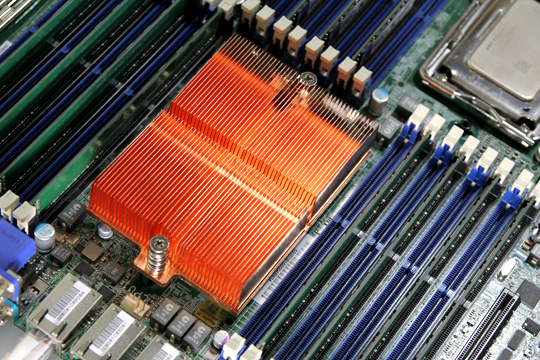Today we are going to take a quick look at the AMD Opteron 6128 CPU which has become a very cost-effective building block for a multi-socket, high-memory system. Intel’s new Xeon E5-2600 series is great. I did a Xeon E5-2687W single socket preview and a Dual socket Xeon E5-2690 review and the performance was awesome. Intel knows that it managed to improve the Xeon architecture over its previous generation parts while AMD’s Interlagos was often beat in efficiency by its AMD Opteron Magny Cours predecessors. With this knowledge, Intel raised prices to the point that its flagship CPUs (the Intel Xeon E5-2690’s) now cost over $2,000 each. Sometimes, one simply needs cores and RAM to virtualize Core 2 Duo/ quad generation Intel Xeons CPUs or to run things such as memchached nodes for applications. Despite the excitement of the Intel Xeon E5 launch, there have recently been values found in the AMD Opteron G34 socket space.I have been looking to build a new server for quite awhile now. Even with good access to current generation server hardware, I decided to look at building a budget multi-socket machine. I decided I wanted a platform I could upgrade if I needed more compute later, so I looked at the LGA 1366 platform (which is now rendered more or less EOL because of the Xeon E5 launch), AMD’s G34 platform, and the new LGA 2011 platform. At the end of the day I decided to build a dual-socket G34 system.
Probably the biggest drivers in deciding on the AMD Opteron G34 platform were the upgrade path, memory capacity and processor cost. On the upgrade path, there are a lot of inexpensive Opteron 6128 CPUs (that ebay link will have some sellers willing to sell two CPUs for $100-125 each) out there to start with and one can go from the 2GHz eight-core 6128 to higher-end twelve Magny Cours or sixteen core Bulldozer-based Interlagos CPUs today and the next generation G34 parts when they arrive. If one can get a relatively inexpensive dual socket motherboard in the $300 range a 16 core 32GB system with tons of expansion slots can cost well under $900 total which is about the same as a Intel Xeon E3-1280, decent C204 based motherboard, and 16GB of RAM.

On the memory side, Facebook actually uses the Opteron 6128 HE in dual socket G34 platforms as memcached nodes (see OpenCompute.org.) The Opteron 6100 series supports eight DIMMs per CPU of both unbuffered and registered varieties. A typical guideline is around 32GB unbuffered ECC (4GB x 8 DIMMs) and 128GB registered ECC (16GB x 8 DIMMs) per CPU. Of course, the new Intel Sandy Bridge-E Xeon family can support more memory per CPU, but I am unlikely to max-out on RAM for the application. Most likely I will stick to VMware ESXi 5.0 32GB “free” verison limit for the time being and 8x 4GB DIMMs are inexpensive.
For those wondering here is the build and the cost breakdown:
- CPUs: 2x AMD Opteron 6128 off ebay – $200
- Motherboard: Supermicro H8DG6-F – $300 used / $600 new
- Memory: 8x 4GB Kingston unbuffered ECC 1333MHz DIMMs – $260
- SSD: OCZ Vertex 3 120GB $130 after MIR
- Power Supply: Corsair AX650 650w 80 Plus Gold – $145 (had on hand)
- Chassis: Norco RPC-450B – $80 (had on hand)
- Cooling: 2x Dynatron A1 G34 Coolers (one is pictured above) – $50 (had on hand)




you should do something about your missing images. Where is the quality control department?
what’s “after MIR”
@patrick Great piece. As the troll pointed out, and congratulations on your first one, your CDN isn’t sync’ing
MIR is shorthand for mail in rebate — very common language
My favorite cheap server processor, the 6128. When I started to design a new compute environment recently I surveyed the performance landscape and settled on Intel Xeon processors… until I saw the prices. If performance/price is a factor – and it should always be – those used 6128s look fantastic. Nice article Patrick, thanks!
@ MySchizoBuddy, pictures display just fine here, and after MIR = after mail in rebate, which is getting your money back.
Try refreshing your page.
Great CPUs and great prices now.
Very good advice, nice article. I did something similar but because I wanted higher single core performance and a dual socket motherboard that fitted in a standard ATX case, so I went with the 4184 processors (6 core, 2.8GHz). Now running 12 cores and 64GB ram with ESXi 5.
Also don’t forget that the current plan from AMD will be to re-use the C32 and G34 sockets for Seoul & Abu Dhabi Piledriver CPUs coming later this year. I’ve found ECC Registered 1333MHz ram to be very cheap over the last few months (£117 per 2x8GB sticks), but as soon as I filled more than 4 DIMMS slots with the 4184 it clocks down to 1066MHz. With Bulldozer and Piledriver my ram should be able to clock back to 1333MHz with all 8 DIMMS fitted. I just hope Supermicro release a bios that fully supports all of these upgrades (I believe they did for Bulldozer).
AMD just released the Opteron 3200. Top model has 8 cores and 16 MB cache and supports 32 GB registered ECC (unlike Intel’s Xeon E3 line which needs Unregistered ECC).
For home and small business servers this could be ideal. 32GB ESX5 with ZFS :)
How does something like these AMDs do in the real world? It seems they need more cores to do even less than a cheaper Xeon setup with fewer cores.